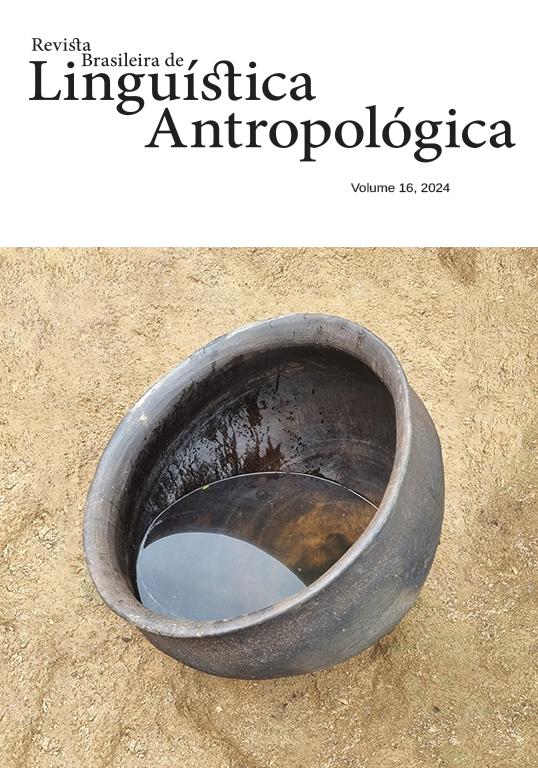Kaxararí phonologies
DOI:
https://doi.org/10.26512/rbla.v16i1.56737Keywords:
Kaxararí, família Pano, Ruth MonserratAbstract
This article is part of a tribute to Ruth Maria Fonini Monserrat and aims to situate her contribution to the study of the phonetics and phonology of the Kaxararí language. In addition to this objective, the article also aims to provide a general overview of studies on the phonetics and/or phonology of the language and to point out issues of interest for future research. The study began with a survey of published and unpublished works on the phonetics and/or phonology of the Kaxararí language. The works of Fr. Békšta (1977), Souza (1986), Silva (1986), Cabral and Monserrat (1987), Sousa (2004), Couto (2005) and Barbosa (2015) were surveyed. An analysis of these works was then carried out and the results of the analysis are summarized in this article in two main sections, one that presents the phonetics and/or segmental phonology presented in each work and another that discusses some phenomena, considering the author(s) who described it and how the issue is addressed in each work. The results are also summarized in tables that summarize the observations presented.
References
Barbosa, R. A. O. 2015. “Uma proposta preliminar de sistema consonantal para a língua Kaxarari (Pano). In: Estudos Linguísticos, 44(1). São Paulo. 202-216pp.
Békšta, Pe. C. 1977 (ms). Kašarari. Subsídios para a alfabetização na língua tribal: situação dos falantes Kašarari. Pesquisa fonética-fonológica. Suguestão: cartilha e leituras. Porto Velho.38p.
Cabral, A. S. A. C. 1987 (ms). “Atualização léxico-semântica de línguas indígenas. Documentação da língua Kaxarari”. Relatório CNPq/FNPM. Brasília, DF: Ministério da Cultura.
Campbell, L. R. 2020. Historical linguistics: an introduction, 4ª ed. Edinburgh: Edinburgh University Press,
Couto, A. Ortografia Kaxarari: uma proposta. Porto Velho, 2005. (versão eletrônica)
Fleck, D. W. 2013. Panoan languages and linguistics. New York: American Museum of Natural History.
Kaufman, T. 1990. “Language History in South America: What we Know and how to know more”. In: Payne, D. L. (ed.). Amazonian Linguistics. Austin: University of Texas Press.
Lanes, E. J. 2005. Aspectos da mudança lingüística em um conjunto de línguas Amazônicas: as línguas Pano. 2005. Tese (Doutorado em Linguística), Universidade Federal do Rio de Janeiro, Rio de Janeiro. 334p.
_____. Mudança fonológica em línguas da família Pano. Dissertação de Mestrado em Lingüística. Programa de Pós-graduação em Lingüística/UFRJ, Rio de Janeiro, 2000. 220p.
Oliveira, S.C. S. de. 2023. “las primeras escisiones de la familia pano: una propuesta de subagrupamiento en una familia de la amazonia occidental”. In: International Journal of American Linguistics (IJAL), vol. 89, N 3. Chicago: The University of Chicago Press Journals. 289-331pp.
_____. 2014. Contribuições para a reconstrução do ProtoPano. Tese de doutorado, Universidade de Brasilia.
Silva, M. L. da. 1986 (ms). “Levantamento estatístico da população Kaxarari”.
Sousa, G. C. 2004. Aspectos da fonologia da lingual Kaxarari. Dissertação (Mestrado em Linguística), Universidade Estadual de Campinas, Campinas, SP.
Souza, I. C. de. 1986 (ms). “Língua: Kaxarari (família Pano)”.
Valenzuela, P.; Guillaume, A. 2017. Estudios sincrónicos y diacrónicos sobre lenguas Pano y Takana: una introduccón. Amerindia 39(1):1–49.
Valenzuela, P.; Zariquiey, R. 2023. “Language classification in western Amazonia: advances in favor of the Pano-Takana hypothesis. In: LIAMES, v. 23, N. 2. Campinas: Unicamp. 1-53pp. https://doi.org/10.20396/liames.v23i00.8670150.
Zariquiey, R., Vera J., Greenhill S. J., Valenzuela P., Gray R. D., List J-M. 2022. Untangling the evolution of body-part terminology in Pano: conservative versus innovative traits in body-part lexicalization. Interface Focus 13: 20220053. https://doi.org/10.1098/rsfs.2022.0053.
Downloads
Published
Issue
Section
License
Copyright (c) 2024 Revista Brasileira de Linguística Antropológica

This work is licensed under a Creative Commons Attribution 4.0 International License.
Authors who publish in RBLA agree to the following terms:
a) Authors maintain the copyright and grant the journal the right of first publication, and the work is simultaneously licensed under the Creative Commons Attribution License, which allows the sharing of the work with recognition of the authorship of the work and initial publication in this journal.
b) Authors are authorized to assume additional contracts separately, for non-exclusive distribution of the version of the work published in this journal (eg, publish in an institutional repository or as a book chapter), with recognition of authorship and initial publication in this journal.
c) Authors are allowed and encouraged to publish their work online (eg, in institutional repositories or on their personal page) at any point before or during the editorial process, as this can generate productive changes, as well as increase impact and citation of the published work.










